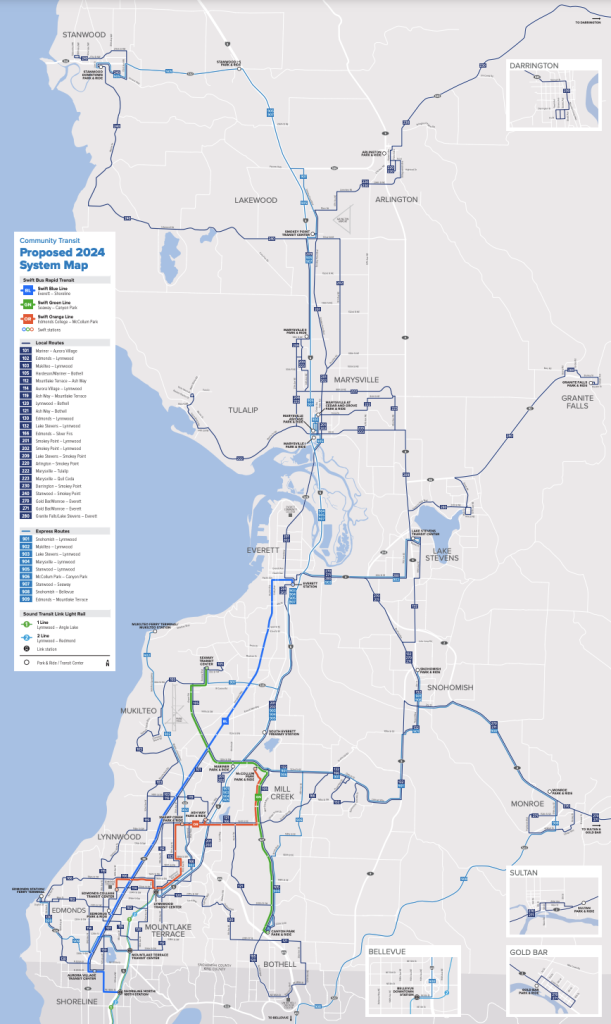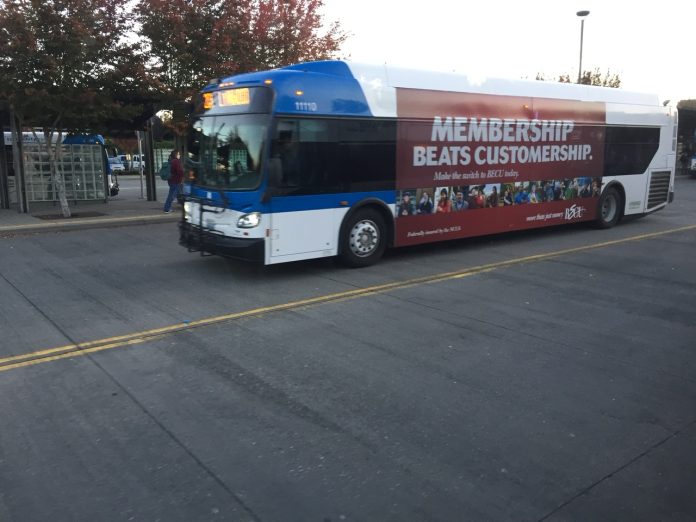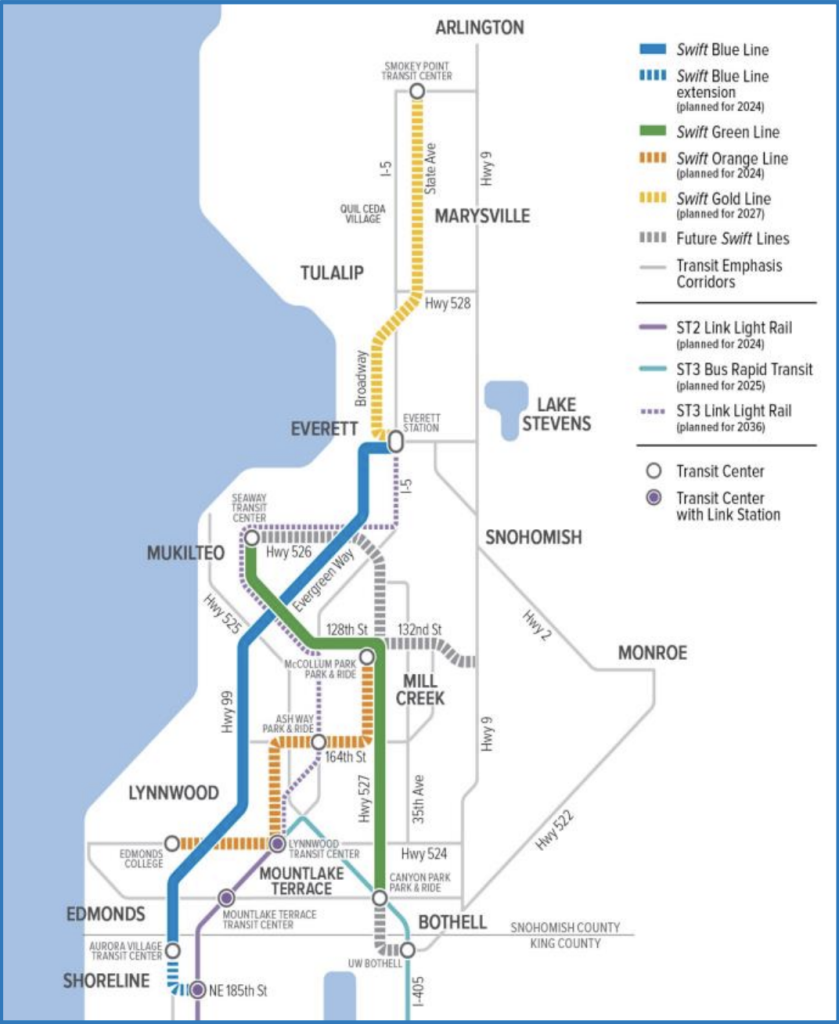Community Transit has unveiled a full proposal to restructure bus service when Lynnwood Link light rail and the Swift Orange Line bus rapid transit open in 2024. The proposal generally means better local service across the county and would end the bulk of commuter bus routes operating into King County. However, it would also mean that some local service may be consolidated leaving some currently served streets unserved and still lacking a large frequent network. The Urbanist recently spoke to Community Transit to better understand the proposal.
Chris Simmons, the agency’s service planning manager said that the system redesign boils down to four primary objectives:
- Tying bus service into Link and Swift stations;
- Providing more access to frequent service by reinvesting existing service hours;
- Adjusting to market changes precipitated by the introduction of light rail and pandemic; and
- Delivering more equitable services for traditionally disadvantaged communities.

The initial system redesign concepts are in a “Zen garden state,” Simmons said, suggesting that it was balanced based on many of the features that public requested in the first round of the planning process. Big requests made at that stage were for more daytime bus trips and a wider span of service, but the public may see the concepts differently now and that could result in notable refinements during the next stage of the process.
As conceived, the system redesign will have a big reach. About 80% of residents in the Community Transit service area will be close to stops and proposed service will reach around 60% of jobs and 417 essential destinations (e.g., doctor offices, schools, libraries, grocery stores, and pharmacies). Most segments, about 95%, of existing local bus service will retain bus service, too.
While the system redesign isn’t exactly creating a big network of frequent service, it will be building a nascent frequent network of local bus routes. Simmons said that top routes newly building that out will include Routes 103, 112, 120, and 130. He said that the agency wants to move to an all-day frequent network, but for now these will be peak-oriented. Riders wanting the most frequent options will need to rely upon Swift lines for now. Fortunately, the Swift network is also growing with the extension of the Blue Line to Shoreline North/185th Station and new Orange Line from Edmonds College to McCollum Park Park-and-Ride (via Lynnwood, Ash Way, and Mill Creek) in March 2024.
The summary of the proposed system redesign follows in the table below. The story continues after the table.
| Route/Line | Weekdays | Saturdays | Sundays | Notes |
| Blue Line | 4:00am to 11:30pm every 10 minutes | 5:00am to 11:00pm every 15 minutes | 7:00am to 9:00pm every 20 minutes | Line extended to Shoreline North/185th Station |
| Green Line | 4:25am to 11:00pm every 12 minutes | 6:00am to 10:00pm every 20 minutes | 7:00am to 9:00pm every 20 minutes | No changes to current line |
| Orange Line | 4:00am to 11:30pm every 10 minutes | 6:00am to 11:00pm every 15 minutes | 7:00am to 9:00pm every 20 minutes | New line from Edmonds College to McCollum Park Park & Ride via Lynnwood Transit Center and Mill Creek |
| 101 | 5:00am to 10:45pm every 30 minutes | 6:00am to 9:00pm every 60 minutes | 7:00am to 9:00pm every 60 minutes | No changes to current route |
| 102 | 5:00am to 10:00pm every 60 minutes | None | None | New route from Downtown Edmonds to Lynnwood Transit Center |
| 103 | 4:30am to 11:00pm every 20 to 30 minutes | 6:00am to 9:00pm every 60 minutes | 7:00am to 9:00pm every 60 minutes | New route from Seaway Transit Center to Lynnwood Transit Center |
| 105 | 4:45am to 9:15pm every 30 to 60 minutes | 6:15am to 9:15pm every 60 minutes | 6:45am to 8:45pm every 60 minutes | No changes to current route |
| 106 | None | None | None | Replaced by Routes 121, 166, and 906 |
| 107 | None | None | None | Replaced by Routes 103 and 902 |
| 109 | None | None | None | Replaced by Routes 132 and 901 |
| 111 | To be determined | To be determined | To be determined | To be determined |
| 112 | 6:00am to 9:00pm every 20 to 30 minutes | 7:00am to 9:00pm every 60 minutes | 7:15am to 9:15pm every 60 minutes | No change to current route |
| 113 | None | None | None | Replaced by Routes 103 and 902 |
| 114 | 5:15am to 10:15pm every 30 to 60 minutes | 7:00am to 9:45pm every 60 minutes | 7:00am to 8:00pm every 60 minutes | New route from Lynnwood Transit Center to Aurora Village Transit Center |
| 115 | None | None | None | Replaced by the Swift Orange Line and Routes 105, 114, and 166 |
| 116 | None | None | None | Replaced by New Route 166 |
| 119 | 5:40am to 8:40am every 60 minutes | 6:30am to 9:30pm every 60 minutes | 8:30am to 8:30pm every 60 minutes | No change to current route |
| 120 | 5:30am to 11:00pm every 30 to 60 minutes | 6:00am to 9:00pm every 60 minutes | 7:00am to 8:00pm every 60 minutes | The route would be extend to Edmonds College and UW Bothell/Cascadia College from its current termini |
| 121 | 5:00am to 10:00pm every 60 minutes | 6:00am to 10:00pm every 60 minutes | 7:00am to 9:00pm every 60 minutes | New route from Ash Way Park & Ride to UW Bothell/Cascadia College via Canyon Park |
| 130 | 5:30am to 10:00pm every 20 to 30 minutes | 6:15am to 9:15pm every 60 minutes | 7:15am to 8:15pm every 60 minutes | No change to current route |
| 132 | 5:00am to 9:00pm every 60 minutes | 6:00am to 9:00pm every 60 minutes | 7:00am to 8:00pm every 60 minutes | New route from Lake Stevens Transit Center to Mariner Park & Ride via Cathcart |
| 166 | 4:47am to 11:00pm every 30 minutes | 6:00am to 10:00pm every 60 minutes | 7:00am to 9:00pm every 60 minutes | New route replacing Routes 116 and 196 |
| 196 | None | None | None | Replaced by New Route 166 |
| 201 | 4:45am to 10:00pm every 30 minutes | 6:30am to 9:15pm every 60 minutes | 7:30am to 9:15pm every 60 minutes | No changes to route |
| 202 | 5:00am to 11:30pm every 30 minutes | 6:00am to 11:00pm every 60 minutes | 7:30am to 10:00pm every 60 minutes | Slight alignment change to route in Arlington |
| 209 | 5:15am to 8:15pm every 60 minutes | 7:00am to 9:00pm every 60 minutes | 8:00am to 8:00pm every 60 minutes | No changes to route |
| 220 | 6:45am to 6:45pm every 60 minutes | 6:15am to 7:15pm every 60 minutes | 7:15am to 7:15pm every 60 minutes | No changes to route |
| 222 | 5:30am to 7:37pm every 60 minutes | 7:15am to 9:30pm every 60 minutes | 7:30am to 7:15pm every 60 minutes | The route would be greatly simplified in Quil Ceda Village and Marysville by eliminating mid-route loops and tails |
| 223 | 5:30am to 7:37pm every 60 minutes | 7:15am to 9:30pm every 60 minutes | 7:30am to 7:15pm every 60 minutes | New route picking up loops and tails of Route 222 in Quil Ceda Village and Marysville |
| 227 | None | None | None | Replaced by New Route 907 |
| 230 | Two trips per day each way | None | None | No changes to route |
| 240 | 6:30am to 7:30pm every 68 minutes | 7:45am to 6:45pm every 60 minutes | 7:45am to 7:45pm every 60 minutes | No changes to route |
| 247 | None | None | None | Replaced by New Route 907 |
| 270 | 4:45am to 4:00pm every 60 minutes | None | None | No changes to route |
| 271 | 5:30am to 9:00pm every 60 minutes | 7:00am to 8:00pm every 60 minutes | 7:00am to 7:45pm every 60 minutes | No changes to route |
| 280 | 5:00am to 8:45pm every 60 minutes | 7:00am to 8:00pm every 60 minutes | 8:00am to 8:00pm every 60 minutes | No changes to route |
| 402 | None | None | None | Replaced by Link |
| 405 | None | None | None | Replaced by Link and Route 102 |
| 410 | None | None | None | Replaced by Link and Routes 201 and 202 |
| 412 | None | None | None | Replaced by Link and New Route 901 |
| 413 | None | None | None | Replaced by the Swift Orange Line, Link, and Routes 166, 201, and 202 |
| 415 | None | None | None | Replaced by the Swift Orange Line, Link, and Routes 103, 166, 201, and 202 |
| 416 | None | None | None | Replaced by New Route 909 |
| 417 | None | None | None | Replaced by New Route 902 |
| 421 | None | None | None | Replaced by New Routes 904 and 905 |
| 422 | None | None | None | Replaced by New Route 905 |
| 424 | None | None | None | Replaced by New Routes 901 and 908 |
| 425 | None | None | None | Replaced by New Route 903 |
| 435 | None | None | None | Replaced by Link and Routes 105 and 906 |
| 810 | None | None | None | Replaced by Swift Orange Line, Link, and Routes 130, 201, and 202 |
| 821 | None | None | None | Replaced by New Routes 904 and 095 |
| 860 | None | None | None | Replaced by Swift Orange Line, Link, and Routes 132, 201, and 202 |
| 871 | None | None | None | Replaced by Link and Routes 102 and 130 |
| 880 | None | None | None | Replaced by New Route 902 |
| 901 | 5:30am to 9:00am and 2:00pm to 7:00pm every 30 minutes in the peak direction | None | None | New route from Snohomish Park & Ride to Lynnwood Transit Center via Cathcart and McCollum Park Park & Ride replacing Routes 109, 412, and 424 |
| 902 | 5:00am to 11:00pm every 30 minutes | 6:00am to 10:00pm every 60 minutes | 7:00am to 9:00pm every 60 minutes | New route from Mukilteo Station to Lynnwood Transit Center replacing Routes 107, 113, 417, and 880 |
| 903 | 5:10am to 8:10am and 3:00pm to 7:00pm every 30 minutes in the peak direction | None | None | New route from Lake Stevens Transit Center to Lynnwood Transit Center replacing Route 425 |
| 904 | 4:34am to 9:34pm and 2:47pm to 7:47pm every 30 minutes in the peak direction | None | None | New route from Marysville to Lynnwood Transit Center replacing Routes 421 and 821 |
| 905 | 5:00am to 10:30pm every 60 minutes | None | None | New route from Stanwood to Lynnwood Transit Center replacing Routes 421, 422, and 821 |
| 906 | 5:30am to 8:30am and 2:45pm to 6:45pm every 30 minutes in the peak direction | None | None | New route from McCollum Park Park-and-Ride to Canyon Park Park-and-Ride replacing Routes 106 and 435 |
| 907 | 4:00am to 6:00am and 3:00pm to 5:00pm every 30 minutes in the peak direction | None | None | New route from Stanwood to Seaway Transit Center replacing Routes 227 and 247 |
| 908 | 4:40am to 8:53am and 3:20pm to 7:40pm every 30 minutes in the peak direction | None | None | New route from Snohomish to Bellevue Transit Center replacing Route 424 |
| 909 | 5:00am to 9:00am and 3:00pm to 7:00pm every 30 minutes in the peak direction | None | None | New route from Edmonds Station to Mountlake Terrace Transit Center replacing Route 416 |
However, the Swift Green Line won’t be extended to UW Bothell/Cascadia College in 2024. In fact, Community Transit hasn’t put a specific date on when the line would be elongated to cover Bothell. That’s because the agency says extension is dependent upon road widening along Bothell Way NE, which Community Transit insists is necessary for travel time consistency.
“[Swift] corridors are typically [located on] larger arterials, meaning three or more total travel lanes,” the agency shared in an email. “Larger arterials provide the opportunity to incorporate speed and reliability infrastructure such as transit signal priority at intersections and transit lane priority along the corridor.” When asked about using bus pullouts for stations as an interim solution, the agency said that they prefer not to use them “…because of the constraint of getting the bus back into the travel lane…”
When asked about the largely no-change rural service levels, Simmons said that the number of coach operators expected in 2024 were a real impediment to delivering more service. He said that other alternatives may be evaluated for rural needs.
Likewise, Simmons said that frequency of service throughout the system is expected to be constrained through 2024 because of staffing shortages, not because of financial resources. All things being equal, Community Transit could deliver much higher levels of service if new hires and retainment outpaced expectations. The agency seems to be taking a cautious approach of under-promising and over-delivering since the pandemic has shaken things up so much for all industries, especially transit.
Martin Manguia, the agency’s communications lead, said that the agency is pushing hard to recruit new operators and staff. Community Transit recently held a virtual job fair and is offering $1,500 signing bonus for operators that complete training and beginning driving. Manguia also said that while some staff are leaving the agency, such as for retirement, a lot of staff are moving into other lines of service, such as maintenance, administrative, and management positions.
Riders can expect a system redesign to go into effect in phases. The earliest pieces could begin to roll out in March of next year, meaning that planning work will need to wrap up this year. In the meantime, the agency wants feedback on the concepts, particularly from regular, local riders. An online open house is available through May 31st with the ability to provide route-level feedback to the agency.
Manguia did offer a heads-up, saying that the agency plans to launch a Comprehensive Plan update soon. That will be a foundational policy document as Community Transit looks to grow and evolve through 2050.
Stephen is a professional urban planner in Puget Sound with a passion for sustainable, livable, and diverse cities. He is especially interested in how policies, regulations, and programs can promote positive outcomes for communities. With stints in great cities like Bellingham and Cork, Stephen currently lives in Seattle. He primarily covers land use and transportation issues and has been with The Urbanist since 2014.




